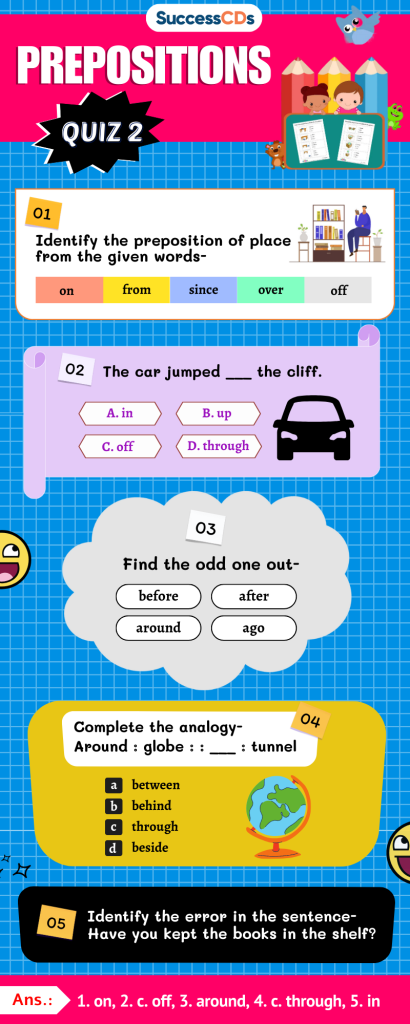
English Grammar – Prepositions Exercises with Answers
Exercises on Prepositions – Embarking on exercises dedicated to prepositions is a fundamental step in mastering the intricacies of language structure. Prepositions, those small but powerful words that indicate relationships between elements in a sentence, play a crucial role in conveying precise spatial, temporal, or directional information. Engaging in exercises on prepositions such as fill-in-the-blank exercises, sentence construction, and contextual application, individuals develop a heightened awareness of how prepositions contribute to the overall structure and meaning of language. While exploring the world of preposition exercises, learners also cultivate a deeper understanding of how prepositions seamlessly guide the flow of language, enriching their communication skills in diverse contexts.Enhance your understanding of prepositions with our easy-to-understand exercises.
- What is a Preposition?
- Function of Prepositions
- Types of Prepositions
- Exercise Set 1:Fill in the blanks- Mastering the Art of Prepositional Phrases
- Exercise Set 2: Use of prepositions with Phrasal verbs and Idiomatic expressions
- Common Challenges and Pitfalls:
- Exercise Set 3: Becoming Proficient with Prepositions
- Conclusion
What is a Preposition?
A preposition, at its core, is a word that links a noun or pronoun to another element in a sentence. Its primary role is to indicate the relationship in terms of space, time, manner, or direction. Prepositions add depth and clarity to language by providing additional context, making the overall meaning of sentences more explicit.
Prepositions are essential linguistic tools that contribute significantly to the structure and coherence of the English language. These words, often small but powerful, function as connectors within sentences, establishing relationships between different elements. Understanding the nuances of prepositions is pivotal for effective communication, as they offer valuable information about time, place, direction, and other key aspects.
Top
Function of Prepositions
The overarching function of prepositions is to clarify relationships within sentences. By expressing connections between various elements, prepositions enhance the comprehensibility of language. They serve as bridges, guiding readers or listeners through the details of when, where, and how actions occur.
- Connection Clarifiers: Prepositions help make sentences clearer by showing how different parts are related.
- Guiding Bridges: They act like bridges, guiding readers or listeners through details of when, where, and how actions happen.
- Spatial and Temporal Guides: Prepositions indicate where things are located (spatial) and when actions take place (temporal).
- Reason Revealers: They unveil the reasons behind actions, answering questions like “why.”
- Comparison Helpers: Prepositions aid in making comparisons between different things.
- Ownership Indicators: They convey ownership or possession, telling us who or what something belongs to.
- Purpose Disclosure: Prepositions express the purpose or goal behind an action.
- Condition Setters: They establish the conditions under which events or actions occur.
Types of Prepositions
- Spatial Prepositions: Spatial prepositions serve to illuminate the spatial relationships between objects or people, offering crucial information about their location. These prepositions answer questions related to where something is positioned. For instance:
- On: The cat gracefully rests on the windowsill, enjoying the warmth of the sun.
- Under: A forgotten pen hides under the notebook on the cluttered desk.
- Beside: John stands confidently beside his sleek car, ready for the road ahead.
- Temporal Prepositions: Temporal prepositions elucidate the temporal aspects of actions or events, providing insights into when something occurs. They contribute a crucial dimension to the narrative of time. Examples include:
- Before: Ensure you complete your homework before the delicious aroma of dinner fills the air.
- After: We plan to meet after the captivating movie concludes its storyline.
- Directional Prepositions: Directional prepositions play a significant role in highlighting the direction of movement or action, aiding in conveying how something is executed. These prepositions guide the flow of activities. For instance:
- To: With purpose, she walked to the store, anticipating her shopping expedition.
- From: Gracefully, the bird flew from the tree, its wings carrying it to new heights.
- Agentive Prepositions: Agentive prepositions specify the means or method by which an action is performed, shedding light on the agent of the action. They provide insights into the tools or instruments used. Examples include:
- By: The heartfelt letter was sent by mail, traveling across distances to reach its recipient.
- With: She meticulously painted the picture with vibrant watercolors, each stroke reflecting her artistic expression.
- Positional Prepositions: Positional prepositions describe the arrangement or location of objects in relation to each other, offering details on how things are positioned within a given space. For instance:
- Behind: The charming house is discreetly positioned behind the lush park, providing a serene backdrop.
- Next to: The bustling school is conveniently located next to the expansive library, fostering an environment of learning and knowledge.
Some examples for different types of prepositions when used in sentences are given below:-
- The shiny keys rest temptingly on the kitchen counter, inviting anyone passing by to pick them up.
- Let’s embark on a leisurely walk before the delightful dinner, savoring the tranquility of the evening.
- With determination, she ran to the bus stop, hoping to catch the next bus to her destination.
- The gentle sunlight filters through the dense foliage of the trees, casting a warm and enchanting glow.
- The captivating book sits snugly between the two bookshelves, waiting to be discovered by an eager reader.
Mastering prepositions involves practice and familiarity with their various uses in different contexts. Precision in their application enhances communication skills, allowing individuals to convey ideas with clarity and accuracy.
Exercise Set 1: Fill in the blanks- Mastering the Art of Prepositional Phrases
a. Fill in the blanks:
- They arrived____________Bombay__________8:00p.m.__________July 30.
- Charles lives____________College Avenue_________an apartment.
- Phoenix is located__________the state_________Arizona.
- John asked me to go_________him to buy a pair________shoes.
- Put a pad_____________the hot dish to protect the table.
- Mr. Walker has__________a gray suit today.
- This story was written__________Conan Doyle.
- My aunt stayed at our house__________two weeks.
- Mary is a good housekeeper; she always sweeps________the bed.
- They had to drive_________ the block four times before they found a parking place.
- There is an ink spot________the collar_________your shirt.
- Please write_________ink, and don’t forget to write__________every other line.
Answers:
- They arrived in Bombay at 8:00 p.m. on July 30.
- Charles lives on College Avenue in an apartment.
- Phoenix is located in the state of Arizona.
- John asked me to go with him to buy a pair of shoes.
- Put a pad under the hot dish to protect the table.
- Mr. Walker has on a gray suit today.
- This story was written by Conan Doyle.
- My aunt stayed at our house for two weeks.
- Mary is a good housekeeper; she always sweeps under the bed.
- They had to drive around the block four times before they found a parking place.
- There is an ink spot on the collar of your shirt.
- Please write with ink, and don’t forget to write on every other line.
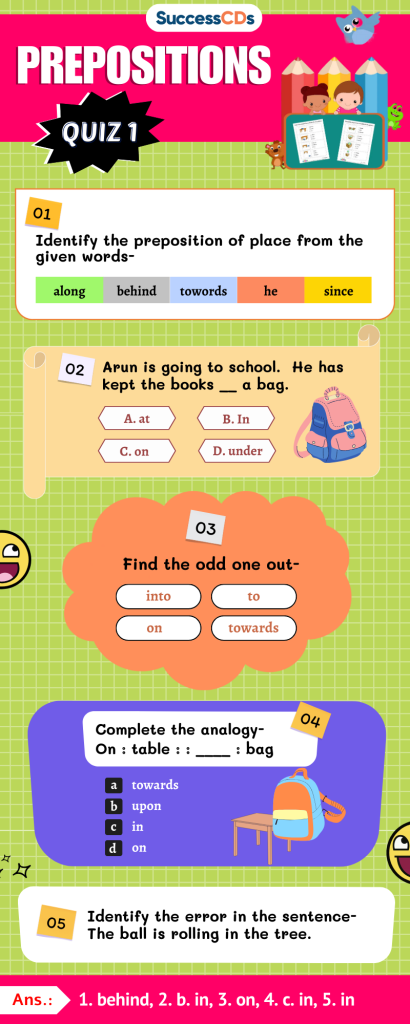
b. Identifying prepositions in given paragraphs:
Read the given paragraphs and identify prepositions in them:
- In the quaint village, Anna sat by the cozy fireplace, sipping her tea on a quiet afternoon. The sound of rain tapping on the window created a soothing ambiance. She thought of her upcoming journey to the mountains, where she hoped to find solace in the breathtaking landscapes.
- As the students gathered in the library, the librarian directed them to the new section of science fiction novels. Each book was neatly arranged in alphabetical order on the shelves. The students eagerly browsed through the titles, searching for an intriguing story to capture their imaginations.
- Walking through the bustling market, Maria couldn’t resist stopping at a vibrant flower stand. She carefully selected a bouquet of colorful blooms, paying for them with her purse. The sweet fragrance of the flowers accompanied her throughout the rest of the day, bringing joy to every step.
- The explorer ventured into the dense jungle, navigating through the thick vegetation. He marveled at the exotic wildlife thriving in this untouched habitat. Suddenly, he stumbled upon a hidden waterfall, cascading into a crystal-clear pool at its base. The beauty of the scene left him speechless.
- At the top of the ancient tower, Emily gazed over the panoramic view of the medieval city. The cobblestone streets winded through historic buildings, creating a picturesque scene. Emily felt a sense of awe at the rich history of the place, imagining the stories that unfolded within its cobblestone alleys.
- As the sun set below the horizon, Mark stood on the edge of the cliff, admiring the vibrant hues of the sky. The waves crashed against the rocks along the shore, creating a rhythmic melody that echoed throughout the surroundings.
- The chef meticulously prepared ingredients, placing each one in a sequence of bowls. He worked with a state of concentration, occasionally glancing at the recipe in his cookbook on the counter.
- Alex embarked on a journey through the ancient ruins, wandering among the remnants of a once-thriving civilization. Moss-covered stones and crumbling pillars stood in silence, telling tales of an era long gone.
- The path meandered through the dense forest, leading hikers to a hidden waterfall. The air was filled with the scent of pine, and the sunlight filtered through the canopy of leaves, creating a dappled effect on the ground.
- Amanda sat at her desk, engrossed in a captivating novel. She was lost in the world of the story, turning each page with anticipation as the plot unfolded.
- The musician performed on the grand stage, surrounded by an enthusiastic audience. The melody resonated through the concert hall, transporting listeners to a realm of pure musical bliss.
- Climbing to the summit of the mountain, Jake marveled at the breathtaking view of the valley below him. The crisp mountain air filled his lungs as he stood in awe of the vast landscape.
- The painting hung on the gallery wall, captivating visitors with its vivid colors and intricate details. The artist had poured creativity into every brushstroke, leaving a masterpiece on display.
Answers:
- In, by, on, of, to, in.
- As, in, to, of, on, through, for.
- Through, at, of, with.
- Into, through, in, at, into, at.
- At, over, through, of, within.
- As, on, of, against, along, throughout.
- With, in, at, on.
- On, through, among, of.
- Through, to, in, with, through, of, on.
- At, in, with.
- On, through, in, through, to, of.
- To, at, of, below, as, in, of.
- On, with, into, with, on.
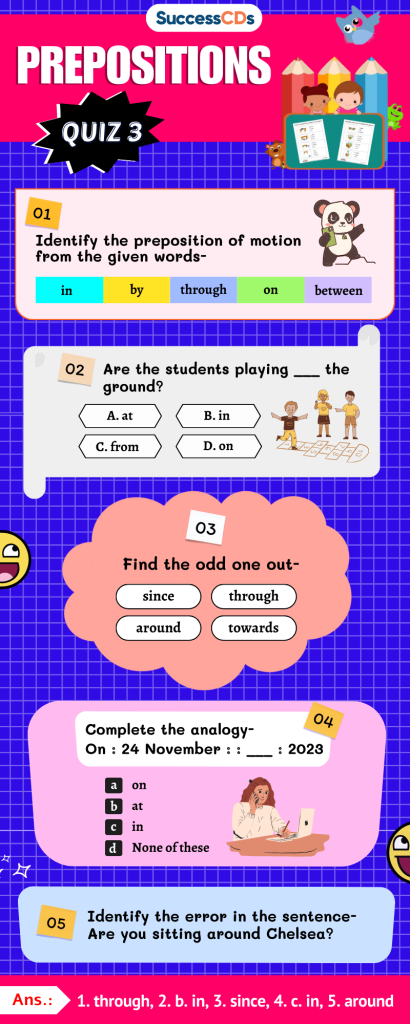
Exercise Set 2: Use of prepositions with Phrasal verbs and Idiomatic expressions
a. Exploring the role of prepositions in phrasal verbs:
Understanding the role of prepositions in phrasal verbs and idioms is essential for effective communication. This set focuses on exploring the intricacies of prepositions within these language constructs.
Example:
- Take after: My son really takes after me; he loves reading.
- Bring up: It’s important to bring up social issues in conversations.
Types of Prepositions in Phrasal Verbs:
- Single Preposition Verbs: These verbs involve a single preposition following the base verb. They often convey a literal direction or movement, as in “climb up,” “fall down,” or “look through.”
- Multi-Preposition Verbs: These verbs use two or more prepositions, often forming more complex meanings. Examples include “put up with,” “get on with,” or “break out of.”
- Separable Verbs: These verbs have a particle (often a preposition) that can be separated from the base verb by an object. For instance, “pick up” can be used as “pick the book up” or “pick it up.”
Functions of Prepositions:
- Defining Direction and Location: Prepositions often indicate the direction of movement or location associated with the verb. For example, “run into” implies an accidental encounter, while “run out of” signifies depletion.
- Specifying Manner and Purpose: Prepositions can describe the way an action is performed or the reason behind it. “Look after” suggests caring for someone, while “look up to” conveys admiration.
- Completing the Verb’s Meaning: Many phrasal verbs rely on the preposition to complete their meaning. Without it, the verb might be incomplete or nonsensical. For instance, “put up with” wouldn’t make sense without the “with” indicating tolerance.
Construct sentences using the given phrasal verbs as showcased in the above examples:-
- Look forward to
- Break up
- Show up
- Turn down
- Come across
- Give in
- Check out
- Catch up
- Put off
- Go through
- Pick up
- Run out of
Answers:
- Look forward to: I always look forward to spending weekends with my family.
- Break up: Unfortunately, my sister had to break up with her long-term boyfriend last month.
- Show up: Don’t forget to show up for the meeting at 9 AM sharp.
- Turn down: Despite the tempting offer, Sarah had to turn down the job because of the long commute.
- Come across: While cleaning the attic, I came across some old photographs from my childhood.
- Give in: After a long negotiation, they finally gave in to our demands.
- Check out: We decided to check out the new restaurant in town that everyone has been talking about.
- Catch up: Let’s grab a coffee and catch up on the latest news.
- Put off: Due to unforeseen circumstances, we had to put off our vacation plans.
- Go through: It’s tough to watch a friend go through such a difficult situation.
- Pick up: Can you pick up some groceries on your way home from work?
- Run out of: I realized we had run out of milk when I was halfway through making coffee.
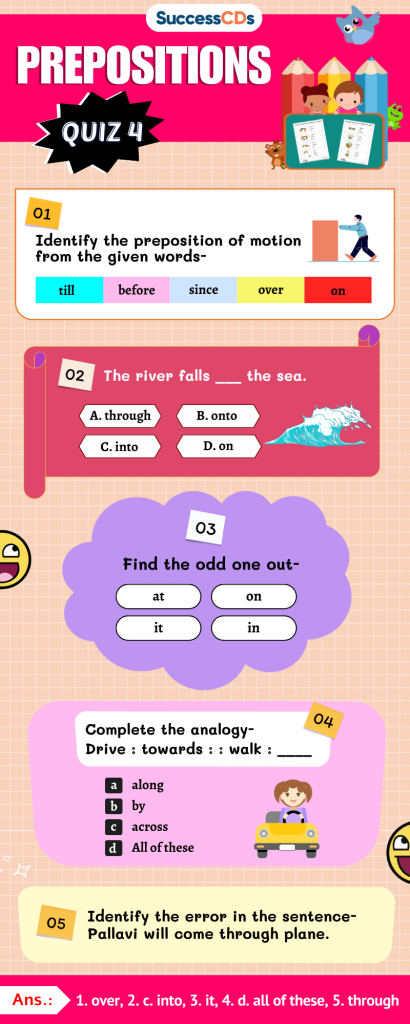
b. Understanding prepositions in common idiomatic expressions.
Understanding prepositions in common idiomatic expressions is crucial for effective communication. Recognizing correct prepositions in idioms and using them contextually enhances your language proficiency, making your expressions more authentic and impactful in everyday conversations.
Example:
- Kick in the bucket.
- Jump on the bandwagon.
Here are some ways prepositions work in idioms:
- Creating Spatial Relationships: Many idioms use prepositions to describe metaphorical relationships between things. For example, “down in the dumps” implies feeling low, while “up in the air” suggests uncertainty.
- Expressing Cause and Effect: Prepositions can link actions and consequences in idiomatic expressions. “Get away with something” conveys escaping punishment, while “get on someone’s nerves” describes bothering someone.
Idiomatic prepositions are frequently used in fixed idiomatic expressions, where the preposition is paired with specific verbs, adjectives, or nouns to create a distinct meaning.
For example: “get on with,” “look out for,” “take care of,” “fall in love with,” “believe in,” etc.
- “She didn’t like her coworker, but she managed to get on with him for the sake of teamwork.”
- “When you go hiking, make sure to look out for snakes on the trail.”
- “I asked my neighbour to take care of my plants while I was on vacation.”
- “He travelled to Italy and fell in love with the beautiful landscapes and rich culture.”
Understanding these roles can help you interpret and use idioms correctly. However, remember that idioms are often non-literal and rely on cultural understanding. Here are some tips for mastering prepositions in idioms:
- Expose yourself to authentic English: Read books, listen to native speakers, and engage in conversations.
- Use dictionaries and online resources: Look for explanations of specific idioms and their prepositions.
- Pay attention to context: Idioms often make sense only within a specific context.
- Don’t be afraid to ask for help: If you’re unsure about an idiom, ask a native speaker or language expert.
Remember, learning idioms is a journey, not a destination. Enjoy the process of exploring these colourful expressions and the fascinating role prepositions play in them!
Fill in idiomatic prepositions you would use to complete the following sentences:-
- He decided to back ___ the project after realizing the potential risks involved.
- They broke ___ the tradition by introducing a modern twist to the annual event.
- The athlete brushed ___ the criticism and focused on improving his performance.
- The team carved ___ a niche in the competitive market with their innovative approach.
- She called ___ her friends for support during the challenging times.
- Despite the setbacks, the company carried ___ with its ambitious expansion plans.
- The artist came ___ a unique painting style after years of experimentation.
- The professor delved ___ the complexities of the subject, providing valuable insights.
- The detective dug ___ the case files, searching ___ any overlooked clues.
- The politician dwelled ___ the importance of unity in his inspiring speech.
- The entrepreneur embarked ___ a journey to revolutionize the industry with cutting-edge technology.
- The author expanded ___ the short story, creating a compelling novel.
- The scientist eventually stumbled ___ a groundbreaking discovery that changed the course of research.
Answers:
- He decided to back out of the project after realizing the potential risks involved.
- They broke away from the tradition by introducing a modern twist to the annual event.
- The athlete brushed off the criticism and focused on improving his performance.
- The team carved out a niche in the competitive market with their innovative approach.
- She called on her friends for support during the challenging times.
- Despite the setbacks, the company carried on with its ambitious expansion plans.
- The artist came up with a unique painting style after years of experimentation.
- The professor delved into the complexities of the subject, providing valuable insights.
- The detective dug into the case files, searching for any overlooked clues.
- The politician dwelled on the importance of unity in his inspiring speech.
- The entrepreneur embarked on a journey to revolutionize the industry with cutting-edge technology.
- The author expanded upon the short story, creating a compelling novel.
- The scientist eventually stumbled upon a groundbreaking discovery that changed the course of research.
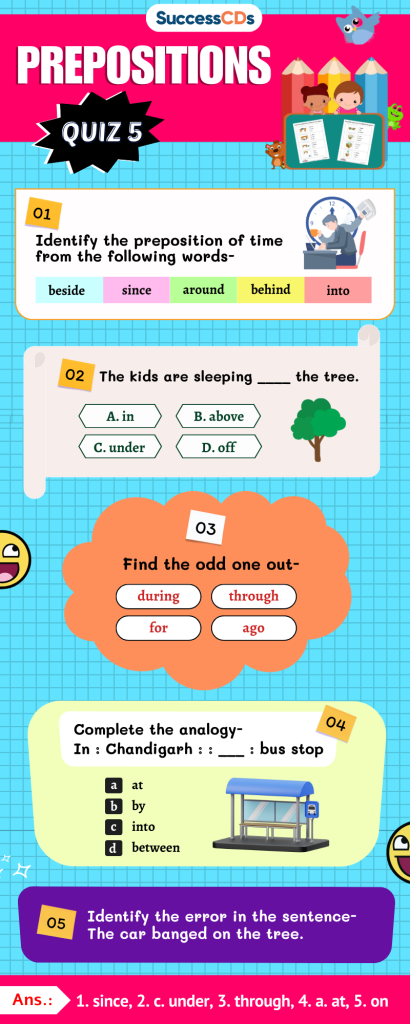
Common Challenges and Pitfalls:
a. Navigating Ambiguity in Preposition Usage:
It can be challenging to understand prepositions because there sometimes exist multiple options. Prepositions are words that indicate the location of something, the time it occurs, or the relationship between things. Saying “The cat is on the table,” for instance, might alternatively mean “The cat is beside the table” or “The cat is near the table.” Selecting the appropriate option relies on your precise meaning.When we discuss time, the similar problem arises. When we say “The meeting is in the morning,” we may equally mean “The meeting is at the morning” or “The meeting is during the morning.” Making the correct choice is crucial because each option modifies the meaning slightly.
When for instance, friends and family plan a party together, we can say “The planning between friends and family.” Or, we might say “The planning with friends and family” or “The planning among friends and family.” The best one to use depends on exactly how everyone is working together for the party.In order to meet this challenge, we should consider carefully what we want to say, and occasionally getting input from others can be helpful. Additionally, it is easier to select the preposition that best expresses our meaning in a given circumstance when we are aware that each one may have a somewhat different meaning. By doing this, we ensure that the meaning we intend for our words is conveyed clearly.
b. Understanding the nuances between similar prepositions:
The ability to distinguish between similar prepositions is essential for accuracy in language. A difference that might be made is between “among” and “between.” When referring to three or more elements, the word “among” is used to highlight the similarities or interactions. However, when “between” is used for two elements, it emphasizes the particular relationship or comparison between those two.
In addition, there are subtle distinctions between the prepositions “in” and “into.” “In” implies placement or inclusion inside a space, but “into” indicates movement inside a space or a change. Accurate expression of these prepositions is made easier by knowing when to use “in” for static situations and “into” for dynamic actions.
These common challenges show how crucial it is to consider the context and intended meaning when choosing prepositions, as even small variations can have a big impact on the message’s correctness and clarity.
Exercise Set 3: Becoming Proficient with Prepositions
a.Understanding Space and Time:
Mastering the essence of space and time in language involves understanding how prepositions, like ‘in,’ ‘on,’ ‘under,’ ‘before,’ ‘after,’ and others, guide our expressions. These words act as linguistic connectors, helping us convey relationships between objects or locations (space) and sequence or duration of events (time).
For instance, ‘in the room,’ ‘on the table,’ or ‘under the chair’ vividly describe spatial arrangements, offering a mental image. Simultaneously, phrases like ‘before the meeting,’ ‘after the event,’ or ‘during the discussion’ employ temporal prepositions, aiding in expressing when actions occur.
Complete the following dialogues:-
Dialogue 1: Coordinating a Team Project
Person A: “We need to finalize our project plan for the upcoming presentation.”
Person B: “Absolutely! Where should we meet? I was thinking _____ the conference room, but it depends _____ its availability.”
Person A: “Good point. Let’s check _____ the schedule to see if it’s free. What time do you have in mind?”
Person B: “How about we meet _____ 3 PM? That should give us ample time to discuss and make necessary revisions. Also, we need to bring _____ all the relevant documents and data.”
Answer:
Person A: “We need to finalize our project plan for the upcoming presentation.”
Person B: “Absolutely! Where should we meet? I was thinking in the conference room, but it depends on its availability.”
Person A: “Good point. Let’s check with the schedule to see if it’s free. What time do you have in mind?”
Person B: “How about we meet at 3 PM? That should give us ample time to discuss and make necessary revisions. Also, we need to bring along all the relevant documents and data.”
Dialogue 2: Planning a Weekend Getaway
Person A: “Let’s plan a weekend getaway to unwind.”
Person B: “Sounds perfect! Where should we go? I was thinking _____ the mountains, but it depends _____ the weather.”
Person A: “Good point. Let’s check _____ the weather forecast before deciding. What time do you suggest we leave?”
Person B: “How about we leave _____ Friday evening? That way, we can make the most _____ the weekend.”
Answer:
Person A: “Let’s plan a weekend getaway to unwind.”
Person B: “Sounds perfect! Where should we go? I was thinking to the mountains, but it depends on the weather.”
Person A: “Good point. Let’s check the weather forecast before deciding. What time do you suggest we leave?”
Person B: “How about we leave on Friday evening? That way, we can make the most of the weekend.”
Dialogue 3: Setting Up a Virtual Meeting
Person A: “We need to discuss the project with the remote team.”
Person B: “Absolutely! Where should we conduct the virtual meeting? I was thinking _____ Zoom, but it depends _____ everyone’s availability.”
Person A: “Agreed. Let’s check _____ everyone’s calendars to find a suitable time. What time zone are our remote team members in?”
Person B: “They are _____ different time zones, so we need to find a time that works _____ everyone.”
Answer:
Person A: “We need to discuss the project with the remote team.”
Person B: “Absolutely! Where should we conduct the virtual meeting? I was thinking on Zoom, but it depends on everyone’s availability.”
Person A: “Agreed. Let’s check everyone’s calendars to find a suitable time. What time zone are our remote team members in?”
Person B: “They are in different time zones, so we need to find a time that works for everyone.”
Dialogue 4: Coordinating a Potluck Dinner
Person A: “Let’s organize a potluck dinner for the team.”
Person B: “Great idea! Where should we host it? I was thinking _____ the office, but it depends _____ the facilities available.”
Person A: “True. Let’s check _____ the availability of the office kitchen. What time do you think would be convenient for everyone to bring _____ their dishes?”
Person B: “How about _____ 6:30 PM? That should give everyone enough time to wrap _____ work and join the dinner.”
Answer:
Person A: “Let’s organize a potluck dinner for the team.”
Person B: “Great idea! Where should we host it? I was thinking at the office, but it depends on the facilities available.”
Person A: “True. Let’s check with the availability of the office kitchen. What time do you think would be convenient for everyone to bring in their dishes?”
Person B: “How about at 6:30 PM? That should give everyone enough time to wrap up work and join the dinner.”
Dialogue 5: Discussing Weekend Plans
Person A: “Any plans for the weekend?”
Person B: “Not yet. Where should we go? I was thinking _____ the beach, but it depends _____ the traffic and crowd.”
Person A: “I agree. Let’s check _____ the traffic updates before deciding. What time do you want to leave?”
Person B: “How about we leave _____ Saturday morning? That way, we can spend _____ entire day enjoying the beach.”
Answer:
Person A: “Any plans for the weekend?”
Person B: “Not yet. Where should we go? I was thinking of the beach, but it depends on the traffic and crowd.”
Person A: “I agree. Let’s check on the traffic updates before deciding. What time do you want to leave?”
Person B: “How about we leave on Saturday morning? That way, we can spend the entire day enjoying the beach.”
b. Cause and Effect Relationships and Directional Precision:
Grasping the dynamics of cause-and-effect connections and achieving precision in describing directions through prepositions is crucial for effective communication.
Prepositions like ‘because of’ and ‘due to’ play a pivotal role in elucidating the relationships between actions and their outcomes, while directional prepositions such as ‘towards’ and ‘across’ serve as linguistic guides, offering a clear path for detailing movement or positioning. Proficiency in using these prepositions enhances language proficiency, enabling a nuanced expression of the reasons behind events and the specific paths they follow.
1. The wall crumbled ______________ the force of the earthquake.
A) under
B) due to
C) towards
D) in
2. The team succeeded ______________ careful planning and coordination.
A) for
B) with
C) because of
D) along
3. Choose the correct preposition for expressing the consequence: “The celebration ensued ______________ the team’s victory.”
A) over
B) through
C) from
D) due to
4. The river flowed peacefully ______________ the mountains, creating a serene landscape.
A) beside
B) towards
C) after
D) with
5. His health deteriorated ______________ a lack of proper nutrition.
A) around
B) in
C) under
D) to
6. The car swerved off the road ______________ a sudden turn.
A) due to
B) along
C) over
D) in order to
7. The marathon runners sprinted ______________ the finish line.
A) across
B) through
C) for
D) into
8. The play was canceled ______________ the lead actor falling ill.
A) in
B) after
C) because of
D) under
9. The detective uncovered the truth ______________ careful investigation.
A) towards
B) by
C) with
D) to
10. The trail led them ______________ the dense forest towards the hidden waterfall.
A) into
B) beside
C) in order to
D) over
11. The negotiations failed ______________ disagreements on key issues.
A) for
B) with
C) due to
D) under
12. The spaceship orbited ______________ the distant planet, collecting valuable data.
A) around
B) in
C) upon
D) between
Answers:
- A) under
- C) because of
- D) due to
- B) towards
- C) under
- A) due to
- A) across
- C) because of
- B) by
- A) into
- C) due to
- A) around
Conclusion –
In conclusion, delving into exercises focused on prepositions proves to be an invaluable journey for language learners. These exercises serve as a dynamic pathway toward mastering the nuanced use of prepositions, enabling individuals to express relationships and connections within language with finesse. By immersing themselves in activities that demand precise prepositional choices, learners not only enhance their grammatical proficiency but also develop a heightened sensitivity to the subtle intricacies of language structure.
Also See:
- Exercises on Prepositions Rules (True or False), Prepositions Exercises
- Preposition of Motion Definition, Types, Exercise and Examples
- Preposition of Place Definition, Types, Exercise and Examples
- Preposition of Time Definition, Types, Exercise and Examples
- Video on Error Detection and Correction of Prepositions
